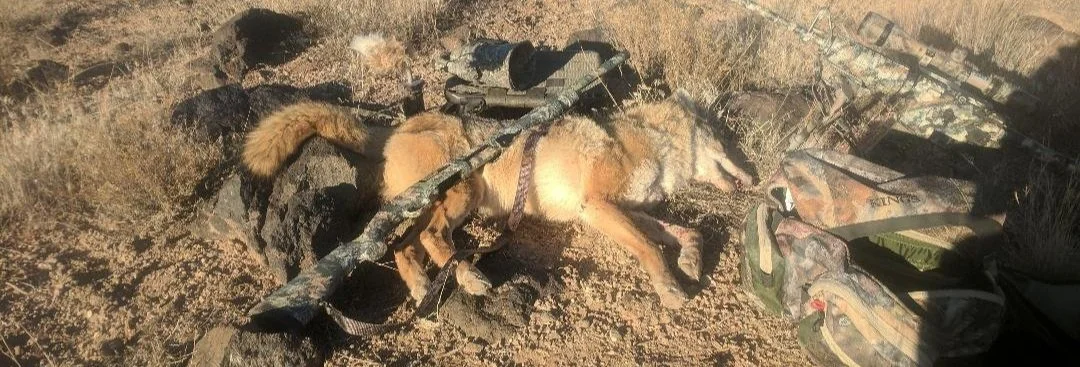Bare Necessities for Coyote Hunting
Getting started in coyote calling doesn’t need to break the bank. In fact, most hunters already own most of the equipment needed to become a coyote hunter. The bare necessities are as simple as transportation, a weapon and a call. Here is a quick look at the minimum requirements as well as some recommendations that will improve your chances.
TRANSPORTATION
Although a high profile four wheel drive or an ATV will allow you to safely access the gnarly and remote areas that are home to the best coyote hunting, the family minivan will get you into some good coyote hunting country. In fact, due to time restraints, most of my recent hunting has been restricted to shorter morning or evening hunting trips. As a result, I have been hunting closer to home and ten of my last 12 coyotes have been called within a half-mile of paved highways.
Not owning a tricked out truck is no excuse to not enjoy a coyote-hunting trip. Gather your gear, do some research to find huntable coyote populations, get off the couch and go hunting. That being said, remember that you don’t want to be stranded in the middle of the desert with a stuck vehicle and no cell phone service. If you want to venture into the sticks, get your hands on a reliable four-wheel drive with good tires. Even then, you will need to use common sense and carry emergency tools and supplies. And always, I repeat, always, tell someone where you are going and when you plan to be back.
Weapon
Any rifle you can accurately shoot out to 100 yards or so will work for coyote hunting. In my first blog of this series I mentioned that my hunting partner was using a 7mm Magnum. Certainly overkill for coyotes, but it will get the job done. My rifle was a .243. A better choice for coyotes, but still the deer-hunting rifle my wife uses.
And don’t forget your shotgun. Lots of coyotes have been called and killed within shotgun range. In fact, lots of hunters have killed their first coyote double because they had a shotgun on hand when multiple coyotes have responded aggressively to a call.
So, grab you deer hunting rifle or bird hunting shotgun and head for the hills for some coyote hunting action.
If you are looking to purchase a coyote-hunting rifle, consider a flat shooting, smaller caliber weapon. Due to its availability, probably the most popular caliber is the .223. This is my weapon of choice and mine are sighted in to be point blank out to 250 yards. Now, there is a misconception, thanks to TV and movies, that point blank means really close. In reality, it means the distance at which you can shoot at, and hit, your intended target without having to adjust your aiming point. Shooting a 50-grain Vmax, my rifle’s trajectory is never more than 1.5 inches high or low out to 250 yards. Since a coyotes chest is about seven inches that means I can hold on center mass and, if I don’t flinch or pull the shot, hit a coyote without changing my aiming point out to 250 yards. I’ll talk more on ballistics and zeroing your gun in a later post.
Another popular coyote hunting caliber is the 22-250. You can’t go wrong with any of the .22 caliber or 6mm center fires. Smaller calibers at lower velocities are definitely more fur friendly if you want to save the hides. Stay away from full metal jacketed bullets. In my opinion, they should never be used to hunt coyotes because they don’t expand and don’t often result in a quick and humane kill.
As for shotguns, look for something with a full choke that will handle buckshot loads. Take the time to pattern your gun by shooting it at a large sheet of cardboard at different distances. I prefer number 4 buckshot and, although I have killed coyotes at 70 yards with this combination, recommend that you restrict your shotgun shots to 40 yards or less.
Calls
Most coyote hunters now days are using electronic or e-callers. These calls vary greatly in features and price and are often more expensive than some are willing to pay at the entry level of coyote hunting.
Not owning an e-caller should never keep someone from taking up coyote hunting. Kerry Carver is a well-known coyote hunter who makes and sells hand calls. He has produced a video called “21 Days In Coyote Heaven” which demonstrates the success that can be had using hand calls. Most of the hunts on this video show coyotes responding to hand calls. Several years ago, Kerry and his partner finished second in the world coyote calling competition. Kerry’s calls start at around $20 and are available on his web site.
Owning and using an e-caller has improved my coyote hunting success dramatically. In my opinion, the biggest advantage of an e-caller is that it can be placed some distance from where you are sitting, focusing the incoming predator’s attention away from you.
This makes it easier to maneuver your weapon into shooting position without being seen and, if placed correctly, harder for a coyote get your scent.
E-callers range in price from under $100 on up to $600 or so. I believe that owning an e-caller can make you a better coyote hunter, but keep in mind that the most successful predator hunters usually carry hand calls and use them in conjunction with electronics. Having a hand call or two can save the day when technical difficulties arise.
To wrap things up, don’t let lack of equipment keep you from hunting. Use what you have or can acquire inexpensively and get off the couch.

